
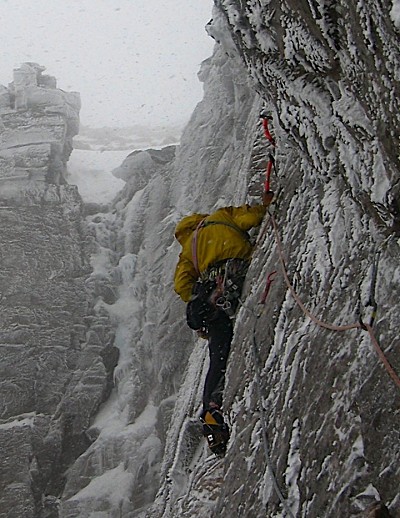
The overall quality and range of kit available to climbers has increased massively over the last decade or so. What follows are my thoughts on modern Scottish winter clothing systems and gear, mostly gained through trial and error with a fair amount of suffering along the way. This is in no way a definitive guide, and others with much more experience may have different approaches and opinions (please share these in the article's forum thread!). In a similar vein, while I use lots of specific examples, these happen to be the kit that I have used - there is plenty of equally good kit that out there that works just as well.
At the end of the day, until artificial-intelligence-climate-control clothes and gear come along (by which point we'll probably be 'climbing' on UKC's virtual reality crags) there's likely to be some suffering involved and, shiny and tempting as new kit is, if you've a system that works most of the time, you're probably better off investing in going climbing!
First, let's look at the problem. Scottish winter climbing broadly involves three activities: walking (uphill and back down) for considerable distance with a heavy pack, climbing: either moving reasonably quickly on easy terrain or more slowly on harder routes, and belaying: AKA standing around for extended periods. All this takes place in a 'varied' climate, ranging from anywhere from around +10 to -10 degrees with high humidity, every variety of precipitation and strong winds often thrown in for good measure. Clothing systems and gear, as best they can, have to try to cope with these different activities across this varied environment, while remaining easy to move in, light enough not to be a pain to lug around, durable enough to cope with rough abuse, and hopefully affordable...
"...The relatively mild temperatures of UK winter only compound the problems faced by clothing systems..."
Starting with the obvious, clothing that works well is clothing that fits - no amount of clever features or advanced fabrics help if they're not in the right place (e.g. sleeves too short, or the cut too roomy), so be prepared to hunt around a bit to find what works best. The relatively mild temperatures of UK winter only compound the problems faced by clothing systems. Clothing needs to protect from the elements and maintain a comfortable temperature, while getting rid of internal dampness from overheating (your sweat!) as quickly as possible. The drier the overall clothing system can stay the better, resulting in a compromise between its ability to keep the elements out, and to get rid of sweat and dry out when temporarily overwhelmed. The overall aim is to find a system that adequately manages this compromise, and is flexible enough to cope with a different range of temperatures, weathers and activities, without having to stop and change every five minutes and carry lots of additional kit.
Top half
Walking-in is a high-energy activity that tends to make you warm (and sweaty) pretty quickly. I find that a thin fast-wicking base layer backed-up with a very lightweight windproof like the Rab Cirrus Pull-on keeps the worst of the elements at bay without causing overheating, and keeps climbing layers dry in the pack. Of course if it's truly hurling it down, you'll need a shell (a very lightweight minimal one like the brilliant Rab Demand works well).
Having slogged to the base of the climb, the base layer and windproof are usually soaked with sweat, particularly on the back where the pack has stopped moisture escaping - less than ideal for the climbing or belaying that follows. A good (though briefly brutal!) way to overcome this is to strip off and change into dry 'climbing layers', ditching the damp 'walk-in tops' in the pack for the rest of the day.
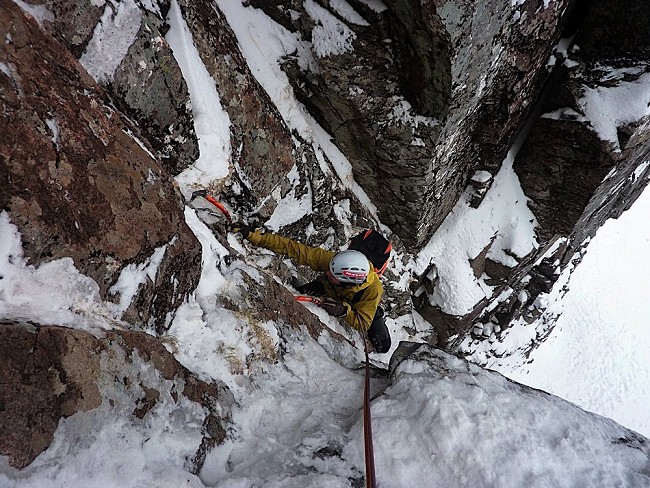
My personal choice of top half 'climbing layers' is as follows. I start with a fresh dry warm base layer - Merino is brilliant. Next comes a lightly-lined windproof wicking jacket, of which the superb Rab Vapour-rise and Marmot Driclime are probably the best examples. With their added protection from the wind (the biggest 'enemy' in maintaining a stable temperature) I find these more versatile than fleece, and on quick moving days (e.g. a winter ridge scramble) often enough on their own.
On top comes an optional 'booster layer'. If I'm expecting to be climbing reasonably quickly (e.g. a gully route) I'll leave this out, but if doing a slower technical mixed route (or it's a cold day) this extra layer is welcome. I usually use a simple fleece waistcoat as my 'booster layer' as it leaves arms less restricted while keeping the core warm. I've recently been experimenting with a new idea that semi-combines the mid and booster layer in the form of the Marmot Variant Jacket, which has impressed so far, and if you run cold something along the lines of the Patagonia Nano Puff would work brilliantly as well.
So, onto the outer layer... It goes almost without saying that this needs a hood that will go over and work well with a helmet, and pockets that are accessible when wearing a harness but these are fortunately now pretty standard.
The main call here is 'soft' or 'hard'. Obviously, 'soft' offers less protection in truly horrible weather (AKA raining sideways), but in most weathers it's a matter of personal preference. I generally favour an unlined (no membrane), very windproof and water resistant soft shell. Over the last few years I've mostly used the predecessor to the Patagonia Ascensionist jacket, though there's plenty of less costly options that are just as good like the excellent Rab Exodus. I find that while soft shells do let more moisture in, they also enable more of it to get out so overall I'm generally more comfortable. If more warmth is needed, a fleece lined soft shell (e.g. one made from Polartec Powershield) is another option, though personally I find these a bit bulky to wear and the fleece can occasionally ice up.
If the greater weather protection of a hard shell is preferred (or the weather demands it), then there's a huge choice out there. I find a jacket around the 500g mark a decent compromise between weight and durability. All the standard (eVent, Gore-tex, H2No, Membrane etc.) fabrics work reasonably well, with the fit probably the most important thing to get right - correct arm length, no annoying bulge in the fabric when wearing a harness that prevents seeing feet etc.
Over the top of the climbing layers goes the belay jacket. The belay jacket concept has made a major difference to the misery of long winter belays. Unless it's perfect weather, a synthetic jacket is generally the better option over down for Scotland, with something weighing around the 600g mark all in e.g. the Marmot Trient or Rab Generator Alpine a decent compromise between warmth at the belay, and bulk and weight in the pack. If very long belays are expected, the extra weight (and warmth) of the likes of the ME Citadel can be worthwhile. Belay jackets are also great for throwing on when gearing up, and even wearing for the first few minutes of the walk-in until warmed up.
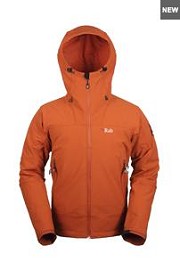
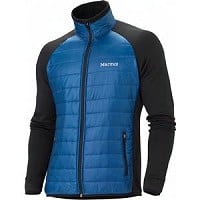
Rab Exodus Jacket (and Pants)
Great soft shell jacket (and matching pants) at a very good price. The very breathable non-membrane fabric is stretchy, very wind and weather resistant with a brushed inner providing a bit of warmth and tough enough to cope with plenty of full body thrutching and thrashing. Pit zips (and thigh vents on the pants) provide additional ventilation when needed and plenty of well-sited decent-sized pockets complete the package. The jacket has a close fitting trim cut with good length in the arms, and a well designed easily adjusted hood. The pants are roomy enough to accept layers underneath, the ankle cuffs are cut to accept ski boots but can be cinched down for climbing boots and loops allow an under-boot-elastic to be fitted. All in all, brilliant soft shell clothing for climbing, mountaineering and ski touring.
More info on the Rab website.
Marmot Variant Jacket
This is an innovative hybrid mid-layer that performs very well under a shell or softshell. Stretch fleece is used on the back, sides and arms where it gives very snug-feeling, close-fitting warmth with great flexibility. On the front, a light synthetic-insulation filled panel gives extra warmth and total wind protection to the core where cold is most felt. The full-length zip makes for easy on-off and allows plenty of ventilation if required, thumb loops on the sleeves keep them from riding up when climbing, an internal chest pocket keeps small essentials (e.g. keys) safe and the snug fitting collar stops spindrift from sneaking in.
More info on the Marmot website.
Bottom half

Moving onto leg-wear ... By far the best winter climbing trousers I've used are the sadly discontinued Patagonia Mixmaster pants. These combine good warmth and weather resistance with excellent ventilation (side thigh zips) for walk-ins allowing one layer to be worn from road to cliff and back. The closest available alternatives (that I know of) are the Patagonia Backcountry Guide pants, Marmot Pro-tour pants or Paramo (see 'alternative systems' below). Alternatively, uninsulated 'alpine' soft shell trousers such as the brilliantly featured Rab Exodus pants (thigh vents are great for walk-ins) or classic Mammut Base Jump pants work fine on their own for fast-moving days, or can be layered with light fleece/merino leggings for more warmth.
On the hard shell front, wearing hard shell pants on a walk-in (chucking it down excepted!) is usually a recipe for unnecessary overheating, so a design with full-length side zips is best as it makes it much easier to get suited at the crag. My personal favourites (probably because they feel more like soft shell than a shell) are the Patagonia Stretch Element pants, but there's loads of good options - once again, the fit is the most important thing to get right. Underneath, stretch fleece leggings, or even better something with a bit of wind-protection like the Marmot Driclime Flex pants or Rab Vapour-rise pants are enough for the walk-in and layer well under the shell when climbing. Needless to say, some wicking underwear under it all works a lot better than cotton! Loops at the bottom of the legs to rig an under-the-boot elastic (strangely few manufacturers seem to fit these) are very useful - and easily self-applied with a bit of DIY. With the right boots these can effectively do the job of gaiters making everything simpler and lighter.
"...My personal favourites (probably because they feel more like soft shell than a shell) are the Patagonia Stretch Element pants..."
Viv's Pick of Current Season Kit:
Patagonia Stretch Element Low Bib Pant
Patagonia have a well-earned reputation for very functional minimalist design and the stretch element pant are no exception. The H2NO stretch fabric breathes well, is durable and has a soft flexible feel which makes it great to climb in. The cut is neat (no crampon snagging bagginess) and the light soft shell 'low-bib' and suspenders neatly prevent any gap opening between the pants and upper layers. Full-length water resistant side zips backed up with an internal stormflap make kitting up straightforward and the well designed internal gaiter (complete with loops to rig an under boot elastic) mates well with boots. Everything needed and nothing more.
More info on the Patagonia website.
Alternative systems
There are of course many alternative systems to that described above. Perhaps the most effective of these is Paramo, which certainly has a loyal following among those who work in the hills in winter. Personally, the cut doesn't suit me and I find it a little hefty but it's certainly worth considering.
Hands
If there's one area that it seems impossible to find a 'perfect' solution to it's hands. While some are blessed with genetically superior circulation most suffer the tortures of hot-aches at some stage. If (like me) you suffer badly from frozen hands you should certainly consider the Marmot wrist gaiters, which make a huge difference by keeping the blood supply to the hands warmer. Although somewhat pricy for a couple of bits of powerstretch, it's a relief that these are finally available in the shops as I'm running out of old leggings to make my own!
Gloves generally work pretty well until they get wet, both from the outside, and from sweat on the inside. I like to have a pair of Powerstretch fleece gloves or simple leather worker gloves for the walk-in and gearing up, to keep climbing gloves dry. For climbing, a pair of warm beefy gloves like the Marmot Work gloves or Rab Latok Ice Gauntlets are good for easy climbing/seconding and belaying, with a pair of thinner more dextrous soft shell (dry out quicker than waterproof gloves inside your jacket on belays, plus they're cheaper!) gloves for leading. I find full leather palms and fingers work best, and leather covered fingertips survive the abrasion of scraping snow off the rock to find holds better. A decent length cuff is also useful to stop snow and ice getting down sleeves.
My current personal favourites are the Rab Baltoro (great long cuff), ME Randonee (great apart from the short cuff) and OR Extravert which all give a good compromise of warmth and dexterity and by using a pile (or wool) lining are easy to get in and out of when damp. To help gloves last out a season a bit of attention with proofing wax and seam grip can help. For long belays, nothing beats mitts, either simple synthetic insulated ones like the Outdoor Designs Summit Inferno or good old Dachsteins.
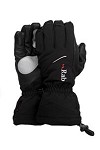
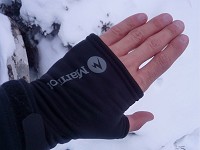
Rab Baltoro Gloves
Great soft shell gloves for technical climbing with an excellent combination of features. The pile lining (backed up with primaloft on the back of the hand) is easy to get in an out of when damp, and gives a good compromise between warmth and dexterity. The fully covered leather palms, fingers and fingertips give a good and durable grip on tools, gear and rope and the tough fabric used on the rest of the glove has withstood the abuse of mixed climbing well. Long cuffs (hard to find these days) stop snow and ice getting down the sleeves and help keep wrists warm. Lastly, the unlined soft shell design means they dry quickly inside a belay jacket, and on the radiator at home!
More info on the Rab website.
Marmot Wrist Gaiter
These gaiters are the best way I've found for helping prevent cold hand problems while allowing thin, dexterous gloves to be worn. Made from medium-weight stretch fleece, they cover the gap between the jacket sleeve and glove keeping wrists, and the blood supply to the hands warm helping to stave off cold fingers and hotaches. The very snug fit and good coverage (up across the palm and half the thumb) means they work better than the less substantial integral thumb loops found on some fleeces but still don't restrict dexterity.
More info on the Marmot website.
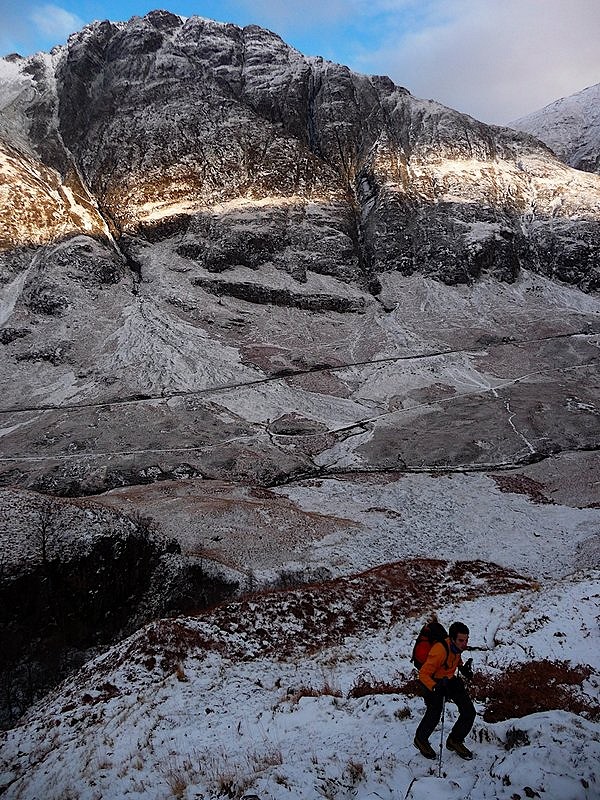
Feet
The long, rough walk-ins, regular soakings and being jammed into and scraped over rock all take their toll on Scottish Winter boots. As with most things, boots are a compromise, between walking comfort/climbing support, weight/warmth/durability and quality/cost.
The 'gold standard' boots are probably still the appropriately yellow La Sportiva Nepal Extreme, which combine good walking comfort, with warmth, durability and great climbing ability, though at a price. Noticeably lighter, even better to climb in but less durable (and pricier) are the new generation of synthetic winter climbing boots. Perhaps the best of these is the latest incarnation of the Scarpa Phantom series - the Guide.
I've used the predecessors to these for the last few seasons and can't fault them for warmth, comfort and climbing performance, though they come with a small mortgage attached... On long 'track' walk-ins (e.g. the Ben path) I often carry my boots in the pack and wear light approach shoes as far as the snowline as I find it comfier (plus expensive boots last longer and get less sweaty). Socks-wise, I find wool works best, using a thin liner and thick outer sock e.g. the excellent Icebreaker liner and Mountaineer to help prevent blisters.
Icebreaker Mountaineer and Liner Socks
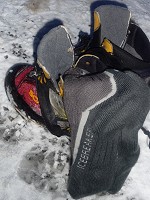
More info on the Icebreaker website.
Something to stick it all in
Gearing up at the road is a somewhat rare experience in Scotland. Something along the lines of the Podsacs Alpine 40 is pretty much ideal for lugging everything to and from the cliffs. I sometimes also take a minimal 'route-pack' along - my favourite being the 70 gram! Sea-to-Summit daypack, which is ideal for taking a belay jacket and some refreshments up a route when you don't want to carry your main packs up - a 'freebie' double draw string sports bag also works well for this.
Spiky things for hands, spiky things for feet
If you've made it this far it's obviously a slow day in the office! Ice axes and crampons have improved massively over the last few years with a huge range now available to suit all purposes and tastes. As evidenced by the fact that many classic routes were first climbed with modified slaters picks and hobnails, any axes and crampons will do, but modern designs certainly make the climbing more fun and easier.
For all-round use, a pair of fully curved tools like the Petzl Quark, DMM Rebel, Grivel Matrix or BD Viper are ideal, working well for everything from easy snow gullies to vertical ice and hard mixed. However, if the focus is on harder routes (approx Scottish VI and up), then dry-tooling derived tools like the Petzl Nomic or BD Reactor and Fusion are worth considering, especially now manufacturers are responding to requests for hammers to be fitted. Leashless is also worth giving a go, using the Grivel Double Spring/BD Spinner or a DIY tether system (lots of suggestions in the forums) if worried about dropping axes. All the tools on the market work very well, with personal preference - i.e. do they 'feel' right to hold and swing probably the most important thing to get right.
Finally onto crampons ... For general use up to about grade IV/V a pair of classic 12-point crampons like the classic Grivel G12 work brilliantly. For harder routes, monopoints make a noticeable difference. Top end designs like the Grivel G20 and Petzl Dart are impressively light, and very precise and nimble to climb in, but at the expense of not allowing worn front points to be replaced as on more all-round but slightly heftier models like the BD Cyborg, Grivel G14 and DMM Terminator. Mixed climbing (particularly on Cairngorm granite) quickly wears crampons down so using an old pair for northern corries snowed-up rock can keep newer ones sharp for the ice.
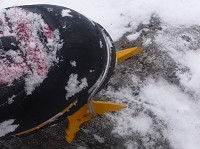
Grivel G20 Crampons
Grivel's response to the Petzl Dart, the G20, is a brilliant out and out performance crampon. As with the Dart, the G20's save weight and bulk over 'modular' climbing crampons by using a one piece front section without replaceable front points. Obviously, this has the downside of being more expensive to replace when the front points are worn, but Grivel's steel is impressively durable so they'll last at least a few seasons provided there isn't too much granite scrabbling involved! The weight saving and reduced bulk of not having additional bolts etc. is genuinely noticeable on steep climbs making the G20s extremely nimble with great 'feel' for climbing in. The point layout is very well thought out: behind the front points the second and third points have a very useful 90+ degree angle between them that locks onto square-cut rock edges very securely, the rear facing third points give added 'smearing' purchase and allow feet to used to pull as well as push.
To join the front and rear of the crampon Grivel use a central 'monorail' which is easily adjusted for length with a single bolt. While this has the downside that the crampons can't be collapsed for day to day transport (and makes them slightly odd to walk in on rocky ground), this 'monorail' gives the end to end rigidity and support of fully rigid 'pie-cutter' crampons like the Rambo without the weight penalty. Completing the package, the heel section is a simple design with fitted antiball plate and the heel clip is secure, simple and easy to use with the strap going just round the ankle giving minimum clutter.
More info on the Grivel website.
I hope at least some of the above made sense and possibly helped - may it be a long, cold and productive winter!
Viv

About Viv Scott
I've been climbing for a bit over ten years, and am currently based in Edinburgh having escaped from the southern flatlands. Climbing highs include Scottish winter climbing, a couple of trips to the Alaska Range, classic alpine routes, sunny ski touring, cragging in the UK and abroad, and beers and craic in the pub afterwards. Lows include Scottish winter climbing, alpine bivies, base camp blues, midges and the UK weather... I guess I'd like to be a jack of all trades and I'm definitely a master of none, but most enjoy the great variety of climbing and look forward to trips back to old favourites and hopefully many new and different places.

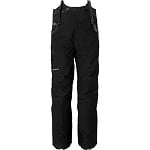

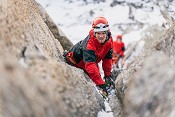
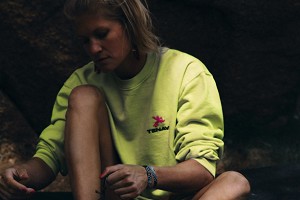
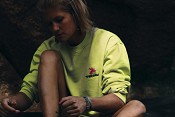




Comments